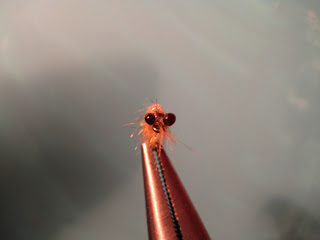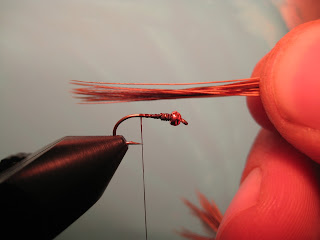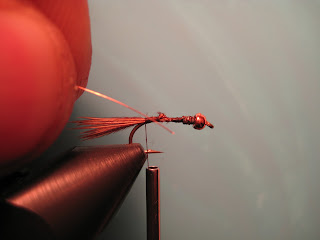Flashback Beadhead Pheasant Tail Nymph
This is another killer pattern that I have had great luck with. I use it when fish are eating darker mayfly nymphs in rivers, or during a callibaetis hatch. I have also read about fish taking this pattern as a midge. This is a go to pattern for me, and there is no better combination to search for fish than a
Gold Ribbed Hare's Ear, and some variation of a Pheasant Tail Nymph dead drifted through a deep bend.
Materials needed:
Hook: Standard nymph hook #12-22.
Thread: Dark brown UTC 8/0.
Bead: Tungsten, or brass, copper color, one size smaller than you would normally use.
Weight: Several wraps of lead wire behind the bead.
Tail: Pheasant tail fibers.
Rib: Small copper wire (wrapped counter-clockwise).
Body: Several pheasant tail fibers wrapped (wrapped clockwise).
Flashback: Large pearl tinsel.
Thorax: Peacock herl.
Legs: Pheasant tail fibers.
Place your copper colored bead on your hook. Use one size smaller than you would normally use for your size hook. For example, I am using a 2mm (5/64) bead for my size 14 hook.
I use a smaller bead to leave enough room for a thorax behind the bead. I think it looks better to have the bead match up perfectly to the thorax as well.
Wrap your lead wire, 10 or so wraps, and push the wraps into the big hole of the bead head. Just like with all weight, this step is optional.
Tightly wrap thread over your lead wire wraps.
If you wrap your thread normally over the lead wire, it will separate the wraps, and leave you with a mess. To remedy this, I always wrap my thread across the lead wraps a few times to keep them together, then you will be able to tightly wrap your thread normally to cover all the lead.
Make sure your lead wraps are tightly secured to your hook shank.
Straighten the tips of some pheasant tail fibers. Measure your tail. The length of the tail should be the length of the hook shank.
Tie in your measured tail with a soft wrap, followed by a few tight wraps.
Cut off the tag end of your pheasant tail fibers, and tie in your copper wire rib on a 45 degree angle (as shown) with a soft wrap, followed by a few tight wraps to bring the wire tightly to the top of the hook shank.
Cut three or four pheasant tail fibers from your pheasant tail feather, close to the stem of the feather. Cut off about a half inch from the tips of the fibers, because the tips are brittle, and they break easy when you wrap your body.
Tie in your tail fibers on a 45 degree angle with a soft turn, then a few tight wraps should bring the fibers tightly to the top of the hook shank.
Tie in your fibers all the way back to the tail. Give yourself one wrap of thread behind the wire rib.
Wrap your thread forward, building a slight taper as you go.
 Wrap the tail fibers forward clockwise around the hook shank.
For the body, I use a technique called counter wrapping. Counter wrapping is wrapping one body material one way, and the rib material the other way. It is used to strengthen fragile body materials, like quill bodies, and fiber bodies. Wrap your pheasant tail fibers either clockwise, or counter-clockwise, just make sure you wrap your rib the opposite way.
Wrap the tail fibers forward clockwise around the hook shank.
For the body, I use a technique called counter wrapping. Counter wrapping is wrapping one body material one way, and the rib material the other way. It is used to strengthen fragile body materials, like quill bodies, and fiber bodies. Wrap your pheasant tail fibers either clockwise, or counter-clockwise, just make sure you wrap your rib the opposite way.

Wrap your rib counter-clockwise around the hook shank. Tightly tie in your rib wire, and break the wire by bending it back and forth near the tie in point.
This is the view from the top.
Tie in some pearl tinsel for a flashback.
Select a few strands of peacock herl, cut the tips off. About an inch.
Again, you cut the tips of the peacock herl off because it's weak, and it will probably break when you're wrapping your thorax.


Tie off your peacock herl, and cut off the tag end.

Tie in six or so pheasant tail fibers on one side of the thorax with two soft wraps.

You can tie the tail fibers in long, with 2 soft wraps.

Pull the pheasant tail fibers to length, about the length of the hook shank.
Keep the fibers on the side of the thorax. Use your other hand to keep the fibers from shifting. You may have to re-tighten your thread wraps.

Once the fibers are pulled to length, cut the tag ends, and tie them off with a few tight wraps.

Tie in 6 legs on the other side of the thorax using the same technique.

Fold the pearl tinsel flashback over the thorax, and tie it off with a few tight wraps of thread.

Whip finish, and apply head cement.
I ended up plucking out some of those fibers making up the tail of the nymph. It looked a little thick to me.







































































